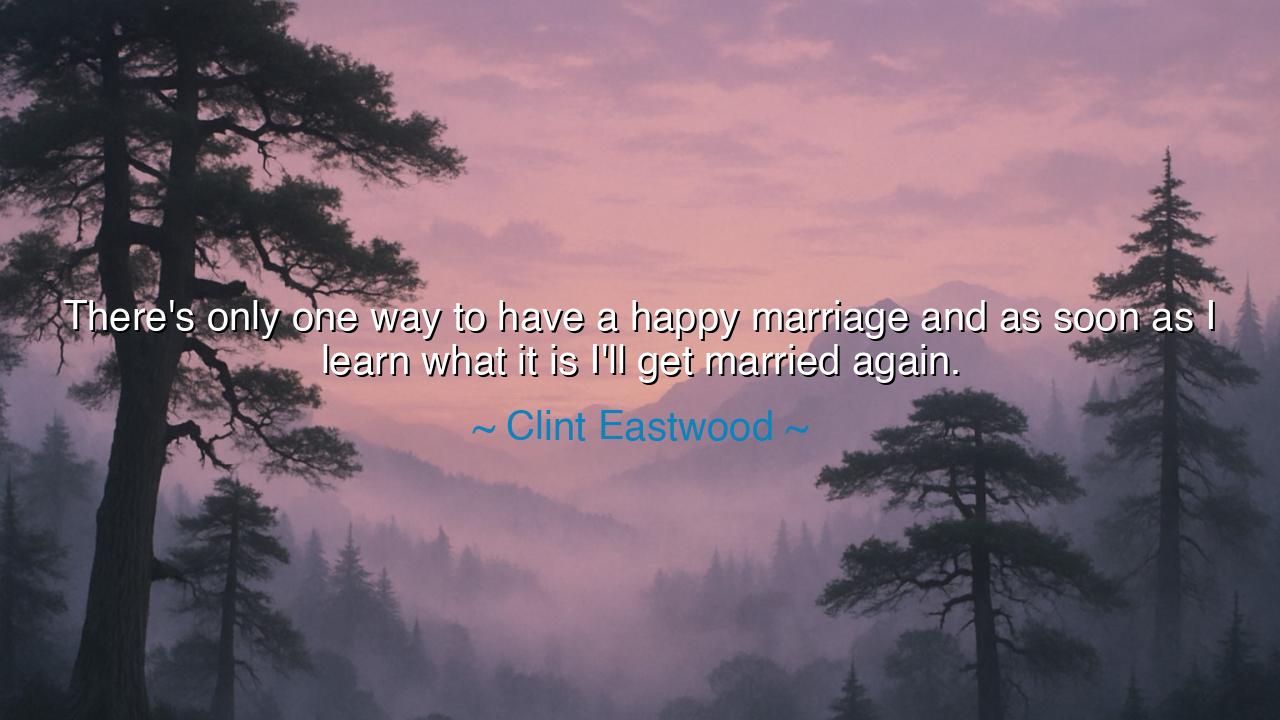
There's only one way to have a happy marriage and as soon as I
There's only one way to have a happy marriage and as soon as I learn what it is I'll get married again.






“There’s only one way to have a happy marriage, and as soon as I learn what it is, I’ll get married again.” So quipped Clint Eastwood, a man known for his grit, silence, and the unspoken wisdom of experience. Though his words wear the robe of humor, within them beats the heart of deep understanding. For marriage, that oldest of human bonds, has never been a matter easily mastered. Eastwood’s jest reveals a truth as old as civilization itself: that the secret to a happy marriage is elusive, ever-changing, and perhaps unknowable in its entirety. His tone may be light, but his insight cuts deep—into the mystery of love, endurance, and the fragile art of human togetherness.
In the ancient days, the sages often said that love is both the greatest joy and the most perilous trial. It asks of two souls not perfection, but perseverance—not sameness, but understanding. Yet Eastwood, having walked through the storms of marriage himself, speaks as one who has felt the weariness of trying to solve a puzzle without an answer. In his jest, we hear not despair, but humility—the recognition that no formula, no counsel, no vow can fully tame the wildness of the human heart. Love, once bound by law or promise, becomes a living thing that must be tended daily, lest it perish. And so, he speaks with the weary laughter of one who has wrestled with love’s complexities and emerged wiser, though perhaps no closer to certainty.
Many through history have sought that same elusive happiness in marriage and failed to grasp it. Consider the tale of King Henry VIII, who married six times in search of affection, legacy, and peace—yet found none. His story, though tragic in its excess, serves as a mirror for every soul that seeks happiness in another before finding peace within themselves. Eastwood’s jest might well have been spoken in any era, for it carries a timeless irony: we spend our lives seeking the perfect union, but happiness in marriage is not discovered—it is created, again and again, by imperfect people learning imperfect lessons.
Yet not all stories end in struggle. Look to Franklin and Eleanor Roosevelt, whose union was marked by trials, betrayals, and yet a bond that transcended mere romance. Their marriage was far from idyllic, yet it endured because it evolved—from passion into partnership, from companionship into shared purpose. They learned, as Eastwood perhaps hints, that happiness in marriage is not a single way but a thousand ways, changing with the seasons of life. The wise do not search for the one perfect method; they adapt, forgive, and grow. In this sense, Eastwood’s humor hides a deeper truth: there is no single path to a happy marriage because love is as varied as the hearts that hold it.
The ancients might have called this understanding the dance of impermanence. Love, they said, is a river—it must move or it stagnates. It is not found by clinging to rules or roles, but by surrendering to the flow of change. A marriage that seeks perfection dies under its weight; one that embraces imperfection finds freedom. So, when Eastwood jokes of learning the secret “someday,” he is really confessing what all wise souls know—that the pursuit of understanding in love is endless, and that humility, not mastery, is the true key to peace.
From this truth arises the great paradox of marriage: happiness is not guaranteed by love alone, nor by effort alone, but by a balance of self and surrender. Two people must learn not only to love each other, but to forgive each other’s humanity. They must learn when to speak and when to stay silent, when to hold on and when to let go. A happy marriage is not built on the absence of conflict, but on the presence of grace—the quiet willingness to begin again after every failure, to choose kindness over pride, and laughter over bitterness.
Thus, dear listener, the lesson is this: there is no single way to a happy marriage, but there are countless ways to nurture one. Be patient, for love matures slowly. Be humble, for wisdom comes through error. Be gentle, for harshness wounds what time is still healing. And above all, be willing to learn, even when the heart is tired, even when the answers are unclear. For perhaps, as Eastwood wryly suggests, the secret of marriage is not to find it, but to keep seeking it together, again and again.
So remember the wisdom behind his laughter: a happy marriage is not a destination, but a lifelong apprenticeship in love. It cannot be taught in words, only lived in deeds. And when you, too, find yourself wondering what the secret might be, smile as Eastwood did—knowing that in the very act of questioning, of striving, and of staying, you are already walking the sacred path that makes two souls into one.






AAdministratorAdministrator
Welcome, honored guests. Please leave a comment, we will respond soon